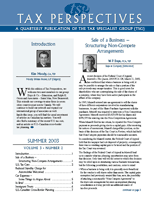
PDF Format
 Issue Contents Issue Contents
 All Issues All Issues
Summer 2003
Volume 3, Number 2
The information in Tax Perspectives is prepared for general interest only. Every effort has been made to ensure that the contents are accurate. However, professional advice should always be obtained before acting on the information herein.
U.S. Tax Cuts
By Stanley C. Ruchelman, J.D., TE
The Ruchelman Law Firm, (New York)
Culminating a process that began with the mid-term elections, the President signed into law the Jobs and Growth Tax Relief Reconciliation Act of 2003 on May 28, 2003. The legislation provides $350 billion of tax relief and $20 billion of aid to state governments. The following are the major provisions of the Act: Reduction in Tax Bracket Rates The Act reduces the top federal tax bracket for individuals from 38.6% to 35% and decreases the interim brackets by 2%. Under prior law, these revisions were scheduled to be implemented over several years. The Act accelerates the effective date of the lower rates to January 1, 2003. Capital Gains The maximum long-term capital gains tax rate is reduced to 15% for most taxpayers and 5% for those taxpayers whose tax does not exceed the 15% bracket (income up to $47,450). Long-term capital gains were previously subject to a maximum tax of 20% for most higher income taxpayers. Dividends The rate of income tax on dividends is reduced from the normal marginal rate (up to 38.6%) to the rate of tax imposed on capital gains, 15% or 5%. The reduced rate for dividends applies to both regular tax and alternative minimum tax. To be eligible for the reduced rates, the dividend must be paid on a share of stock held for more than 60 days before the ex-dividend date. The reduced rate will apply to dividends from foreign corporations eligible for the benefits of a comprehensive income tax treaty with the U.S., provided that the Treasury Department determines that the treaty is satisfactory, and provided further that the treaty includes an exchange of information program. The treaty between the U.S. and Barbados is expressly unsatisfactory in light of the corporate inversion transactions that have used Barbados as the place to reincorporate. Dividends from a foreign corporation will qualify provided: (i) the foreign corporation is eligible for treaty benefits for substantially all of its income in the taxable year in which the dividend is paid, or (ii) the foreign corporation's stock is readily tradable on an established securities market in the U.S. This takes direct aim at foreign corporations using tax havens and may have far-reaching implications. Dividends received from a foreign corporation that was a foreign investment company (Code §1246(b)), a passive foreign investment company (Code §1297), or a foreign personal holding company (Code §552) do not qualify. If a dividend from a foreign corporation qualifies for the reduced rate, 57% of the dividend income will be characterized as U.S. source income to reflect the difference in tax rates between the dividends (15%) and ordinary income (35%). This will have implications in claiming a foreign tax credit. Alternative Minimum Tax The Act increases the AMT exemption amount for married taxpayers filing a joint return and surviving spouses to $58,000, and for unmarried taxpayers to $40,250 for taxable years beginning in 2003 and 2004. The alternative minimum tax is designed to ensure that all persons pay tax notwithstanding the deductions and other tax benefits to which they are entitled. If the income tax is less than the tentative alternative minimum tax, the taxpayer owes the difference as alternative minimum tax. The alternative minimum tax was designed to counter tax strategies of the wealthy. However, its scope has now begun to cover a substantial number of middle class taxpayers. For an individual, the tentative minimum tax is 26% of the first $175,000 ($87,500 in the case of a married individual filing a separate return) of alternative minimum taxable income in excess of an exemption and 28% of the balance. The maximum tax rate on net capital gains is 20%. The tax cuts will make more people subject to the AMT. Other Comments The tax cuts widen the gap between the rates in Canada and those in the U.S., subject to state tax considerations. This is now especially pronounced on dividends. Also, keep in mind that the top tax bracket is not reached in the U.S. until family income exceeds around Cdn $500,000, five times the Canadian top bracket. Notable by their absence from the Act, but likely to be resurrected, are provisions that were adopted in the Senate, including: - Mark-to-Market rules for expatriating citizens and long-term residents;
- Provisions to discourage corporate inversions;
- Determination of basis for amounts paid from foreign pension plans;
- Repeal of the foreign earned income exclusion for citizens or residents living abroad;
- Minimum holding periods for foreign tax credits with respect to withholding taxes on income other than dividends;
- Clarification of the economic substance doctrine, the U.S. equivalent of GAAR;
- Enhanced penalties for understatements of tax arising from transactions lacking economic substance;
- A response to the WTO decision regarding foreign sales corporations and the extraterritorial income exclusion;
- A limitation on the scope of foreign rabbi trusts;
- Anti-tax shelter provisions such as the adoption of an exception to confidentiality privileges relating to taxpayer communications and mandatory disclosure of reportable transactions by material advisors;
- Enhanced penalty provisions for failure to report interests in foreign financial accounts;
- Expanded authority to disallow tax benefits under Code §269;
- Modification of controlled foreign corporation/passive foreign investment company coordination rules;
- Modification of treatment of closely-held REIT's; and
- Denial of tax deductions for punitive damages.
In light of all the provisions that were proposed but not acted upon, the tax legislative agenda may be extremely active in the third and fourth quarters of this year.
|